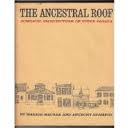 Anthony Adamson, the architect who designed Upper Canada Village and oversaw the restoration of Hamilton’s Dundurn Castle, has died in Toronto (May 2002) at the age of 95.
Anthony Adamson, the architect who designed Upper Canada Village and oversaw the restoration of Hamilton’s Dundurn Castle, has died in Toronto (May 2002) at the age of 95.
Descended from some of the most wealthy and historic families in Upper Canada, Adamson used to joke that he had been “relatively successful in the inheritance business.” If so, he also achieved a more genuine success as a leading authority on Ontario’s architectural heritage.
He co-authored several books on Ontario heritage buildings including the masterful The Ancestral Roof: The Domestic Architecture of Upper Canada, written with his longtime collaborator Marion Macrae and published in 1963. Later in life, he compiled a massive, semi-autobiographical family history whose title, Wasps in the Attic, was a subtle reflection of his often satirical and self-deprecating stance towards his own ancestry and position of privilege.
During his varied career he was a university professor, town planner, and municipal reeve. He was also the founding chair of the Ontario Arts Council and served on the National Capital Commission, the Ontario Heritage Foundation, the Architectural Conservancy of Ontario and other organizations. He was the recipient of a Governor General’s Award, the Order of Canada, and honourary degrees from Queen’s University and the University of Windsor.
Above all, he was celebrated for his thorough knowledge of Ontario architecture of the pre-modern era. “You could bring him a piece of door frame from a building and he’d say, ‘That’s from Wellington County about 1832’ — he had that sort of knowledge,” said Norman MacDonald, a St. Catharines architect. “And he knew his moldings. It’s a compliment to say that of a restoration architect.”
“There were very few people in the province who knew as much about the older stock of buildings,” said his friend, Stephen Otto, who recalled how effective Adamson was at the Ontario Heritage Foundation, where Otto was executive director for heritage conservation. “Tony knew what he was talking about and he knew how to get his point across. He had a very engaging manner and he could charm the birds out of the trees, which is always important when dealing with organizations.”
He was born in 1906 as the second son of Col. Agar and Mabel Cawthra Adamson. His father, whose family had arrived in Upper Canada shortly after the 1837 rebellion, was an army captain in the Boer War and the First World War. His mother was one of the Cawthras, a wealthy, well-established family sometimes described as “the Astors of Canada.” Around that time his parents operated a decorating firm. “When not involved in decorating the new Royal Alexandra Theatre and the Senate Chamber, as well as numerous private houses, they lived as most Toronto aristocrats of the period lived, riding to hounds and giving dinner parties,” writes historian Sandra Gwyn.
In accordance with family tradition, Anthony was sent off to military school in England. At age 10, equipped with top hat and cane, he watched as his father was invested by the King with a Distinguished Service Order; afterwards father and son dined at the Ritz. (Agar Adamson died in 1929, two months after being rescued from a plane crash in the Irish Sea.)
Educated at Cambridge and the University of London, Anthony went into partnership with the noted Toronto architect Eric Ross Arthur in 1930, and married Augusta Bonnycastle, a descendant of the prominent Bonnycastle and Boulton families, in 1931. He contracted tuberculosis in 1935 and was sidelined for seven years as his wife shepherded him to the best sanatoriums around the continent. Cured in 1943, he soon after took what his son, Adrian Adamson, calls “his first paying job” as a professor at the University of Toronto, where he taught architectural history and town planning for more than two decades.
Perhaps inspired by his older brother, Rodney, who had been an MP for the Toronto riding of York West, Anthony ventured into politics. (Rodney and his wife Cynthia were killed in a mid-air crash over Moose Jaw in 1954.) He held various elected municipal positions, including reeve of Toronto Township, for more than a decade. He also sought the nod as a provincial Conservative candidate but lost to William Davis, the future premier.
In 1956, he persuaded the St. Lawrence Parks Commission to assemble a unique heritage village near Morrisburg, Ont., by relocating dozens of old buildings from lands that were about to be flooded by the nascent St. Lawrence Seaway.
As chief designer and general consultant for Upper Canada Village, he “spent over three years touring Ontario with an 1834 road map,” he writes in Wasps in the Attic. He drove around in “an immense Lincoln car” accompanied by Augusta and Marion Macrae, the American PhD student who would become his professional collaborator. Whenever they spotted a house or building of interest, they would knock at the door and request admittance. “Augusta, with all the grace of the Family Compact — and a little splash of diamonds — would engage the lady owner in trivial matters. I would rush about every room making plans and sketches, and Marion would walk around sensing the interior.”
Upper Canada Village opened in 1961; Adamson was an honoured guest at its 40th anniversary celebrations last summer. He was also a consultant on the restoration of Dundurn Castle, the first Italianate house in North America, completed in 1967. “It was a very extensive restoration,” said Dundurn curator Bill Nesbitt. “I’m still using the restoration notes that they put together in the ‘60s. That’s how good the work was.”
Besides The Ancestral Roof, he and Macrae produced Hallowed Walls, a book about provincial churches (1975) and Cornerstones of Order, which focused on Ontario courthouses and town halls (1983).
Wasps in the Attic was published privately in 1987. It was based in part on family papers found in many “obsolete suitcases” in the attic of the family cottage at Grove Farm, a property in Port Credit, Ont. that had been in family since 1806; it was later expropriated, and the house on it is now the Adamson campus of the Royal Conservatory of Music. Adamson removed more than 60 document boxes to his 1860s-era mansion in Toronto’s Rosedale neighbourhood.
He was predeceased by his wife Augusta in 1997 and by his middle son, Inigo, in 1977. He is survived by son Adrian, a retired teacher, and daughter-in-law Esther; son Jeremy, a curator at the US Library of Congress, and daughter-in-law Ingrid; and numerous grandchildren. ♦
Originally published in the Globe and Mail, © 2002.






